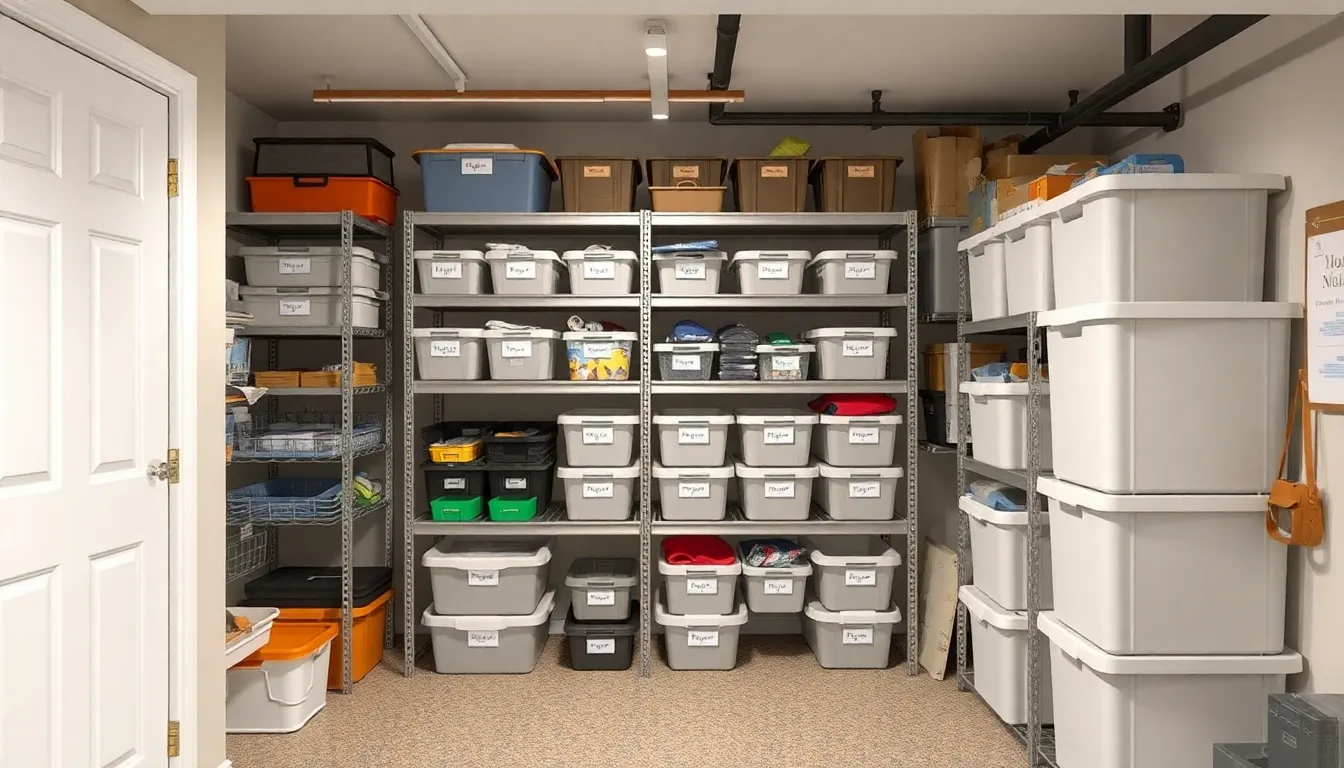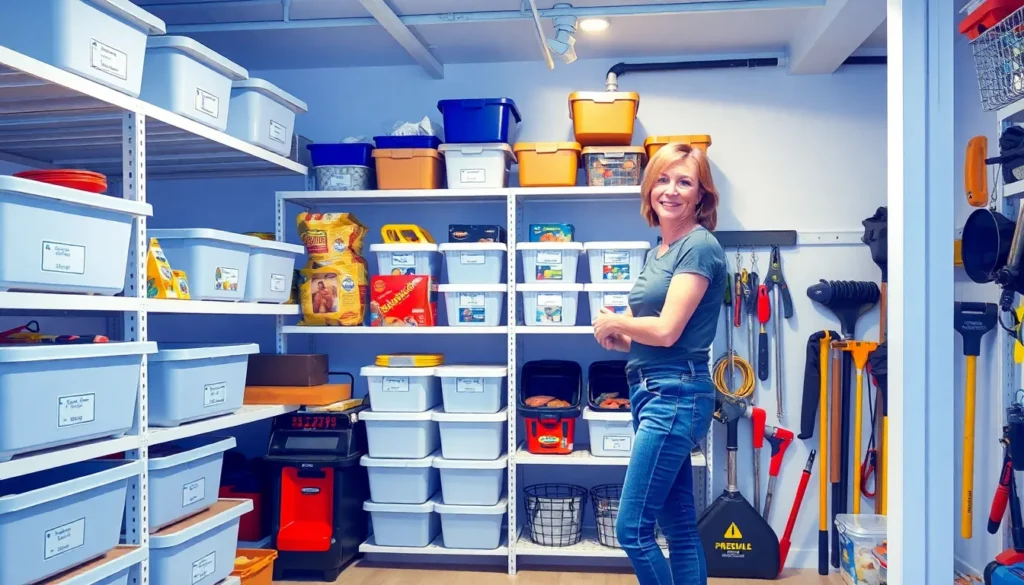Table of Contents
ToggleWhen it comes to storage solutions, the basement often gets a bad rap. It’s the dark, mysterious place where forgotten treasures and questionable holiday decorations go to die. But what if that neglected space could transform into the ultimate storage haven? With a little creativity and organization, a basement can become a treasure trove rather than a tomb.
What Is Basement Storage?
Basement storage refers to the use of basement spaces to store items securely and efficiently. Homeowners often utilize these areas for keeping seasonal decorations, tools, or forgotten belongings. This storage method allows for maximizing space within the home, providing a designated area for items not regularly accessed.
Organizing a basement can transform it from a cluttered zone into a highly functional storage solution. Simple storage solutions, like shelving units, bins, and pegboards, play a crucial role in optimizing space. By incorporating these elements, homeowners create an accessible and neat environment.
A well-planned basement storage system enhances overall home organization. Safety should remain a priority, ensuring that heavy or hazardous items are stored responsibly. Implementing the right storage materials, such as moisture-resistant bins, can prevent damage to belongings.
Accessibility holds significant importance in basement storage. Items need to be easy to reach without causing obstruction or clutter. Regularly reviewing and reorganizing the stored items keeps this area manageable and functional.
Factors like temperature and humidity affect basement storage conditions. It’s essential to ensure proper ventilation to maintain a dry space, protecting stored items from mold growth. Therefore, taking these precautions enhances the durability of belongings.
People often overlook basements as valuable storage areas. With thoughtful planning and organization, these spaces can effectively manage household items while utilizing otherwise wasted space. A dedicated basement storage plan can lead to a clearer, more organized home environment.
Advantages of Basement Storage

Basement storage offers several key benefits that can significantly enhance a home’s organization and functionality. Many homeowners find the following advantages appealing.
Maximizing Space
Maximizing space in a basement transforms it into a valuable storage area. Organized shelving units allow for vertical storage and free up floor space. Using stackable bins eliminates clutter and helps categorize items, making retrieval simple. Effective use of corners and alcoves can turn wasted areas into efficient storage solutions. Properly planned basements can accommodate seasonal items, tools, and memorabilia, providing ample room for various belongings.
Protection from Weather
Protection from weather elements is another significant advantage. Basements typically maintain a stable temperature, providing a safe environment for sensitive items. Moisture-resistant materials, like plastic storage bins, shield valuable possessions from potential damage. Additionally, covered basements help guard items against extreme temperatures. With proper ventilation, basements can remain dry, reducing the risk of mold growth and ensuring long-term protection.
Security Benefits
Security benefits greatly enhance basement storage effectiveness. Basements often offer a more secure location for valuable possessions compared to above-ground storage options. With fewer windows and potential points of entry, these spaces are less vulnerable to theft. Installing sturdy doors and locks increases security measures. Additionally, basement storage can be organized in a way that keeps important documents and items out of sight and away from prying eyes.
Types of Basement Storage Solutions
Basement storage solutions come in various forms, each catering to different needs and preferences. Implementing the right options can transform the efficiency of the space significantly.
Shelving Units
Shelving units provide a sturdy solution for organizing items vertically. They allow homeowners to maximize floor space while offering easy access to stored belongings. Adjustable shelves accommodate different item sizes, enhancing versatility. Open shelving promotes visibility, making it simpler to find items quickly. Metal, wood, or plastic materials offer durability and resistance to moisture, which is essential in basements.
Storage Bins and Containers
Storage bins and containers help categorize items within the basement effectively. Clear plastic containers make it easy to identify contents without opening them, saving time during searches. Stackable designs optimize space, ensuring the organization remains intact even in tight areas. Various sizes and colors enable personalization, allowing homeowners to create a visually appealing storage system. Using labeled containers can further streamline the access process and maintain organization.
Climate-Controlled Options
Climate-controlled options protect sensitive items from fluctuating temperature and humidity conditions. Basements often experience extreme conditions, which may damage equipment and important memorabilia. Utilizing climate-controlled storage ensures consistent environments that safeguard valuable possessions. Some homeowners may consider professional storage facilities that offer specialized climate control for additional peace of mind. Investing in these options can prevent mold, mildew, and deterioration, preserving the integrity of stored items.
Tips for Organizing Your Basement Storage
Organizing basement storage requires strategic planning and execution. Following certain practices enhances efficiency and accessibility.
Categorizing Items
Start by grouping similar items together. Seasonal decorations can form one category, while tools and gardening supplies can constitute another. Grouping items reduces confusion and makes retrieval easier. Consider creating categories based on frequency of use. Items accessed regularly should be placed near the entrance, while seldom-used items can occupy corners. This method streamlines the search process, ensuring that everything has its designated spot.
Labeling Storage Bins
Labeling storage bins enhances organization significantly. Clear labels provide immediate identification, minimizing search times. Use large, easy-to-read fonts for visibility. Color coding also adds an extra layer of organization, allowing quick visual identification of categories. Ensure labels remain updated as items change or move. Consistency in labeling promotes a tidy environment. It becomes easier to find what one needs, fostering a sense of order in the basement.
Regular Maintenance and Decluttering
Regular maintenance prevents clutter from accumulating. Schedule check-ins every few months to review stored items. During these sessions, assess each item’s necessity. When items are no longer needed, consider donating or discarding them. This practice reduces overcrowding and keeps everything manageable. Committing to regular inspections ensures the basement remains functional and organized. Establishing a decluttering routine minimizes stress and cultivates a more serene storage environment.
Transforming a basement into a well-organized storage area can significantly enhance both functionality and aesthetics. By utilizing smart storage solutions and prioritizing safety and accessibility, homeowners can reclaim valuable space and protect their belongings. Regular maintenance and strategic planning ensure that the basement remains a clutter-free haven. With a little creativity and effort, a basement can evolve from a neglected area into a vital part of a home’s storage strategy. Embracing these principles not only maximizes space but also contributes to a more organized and efficient living environment.




